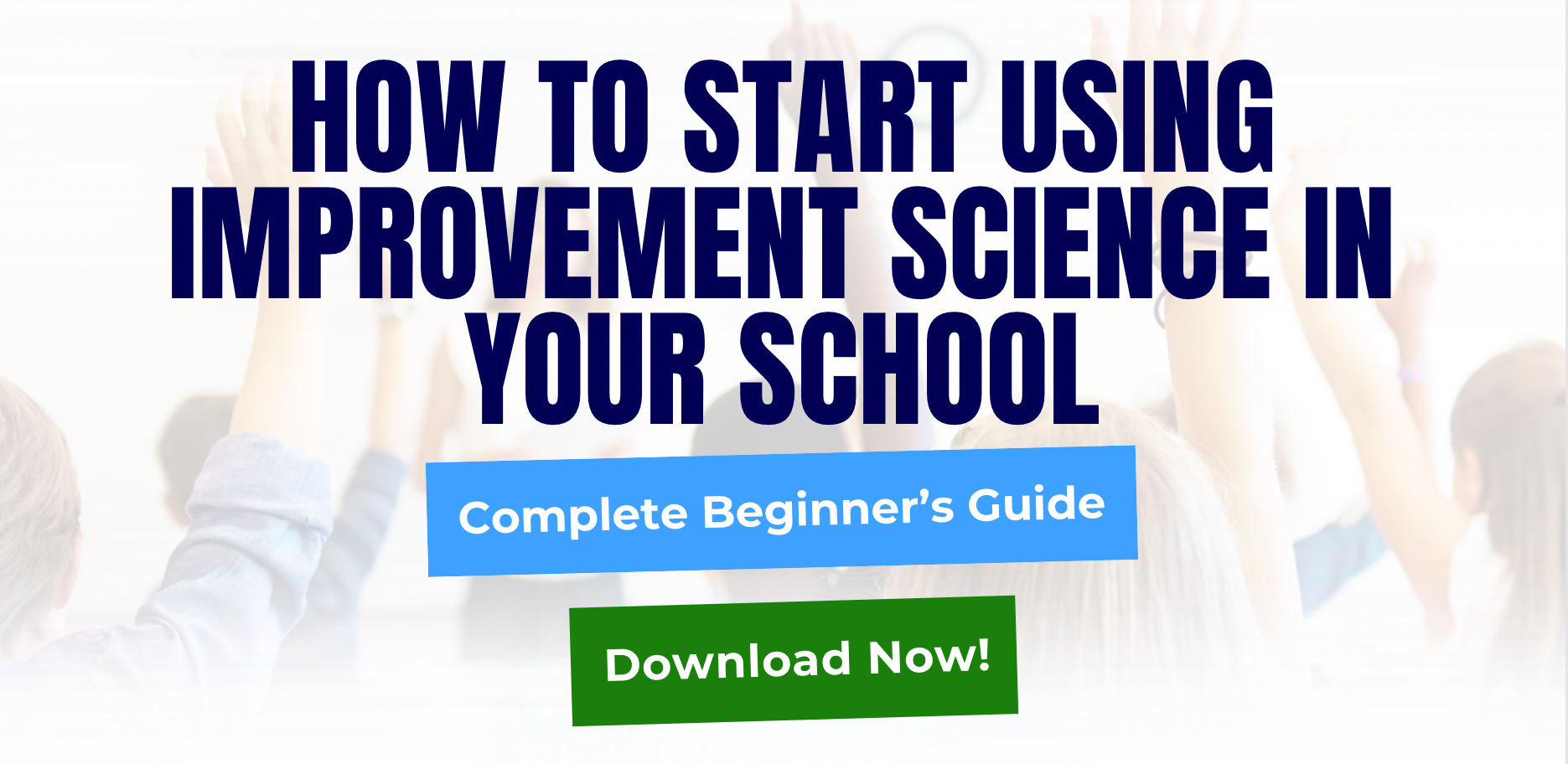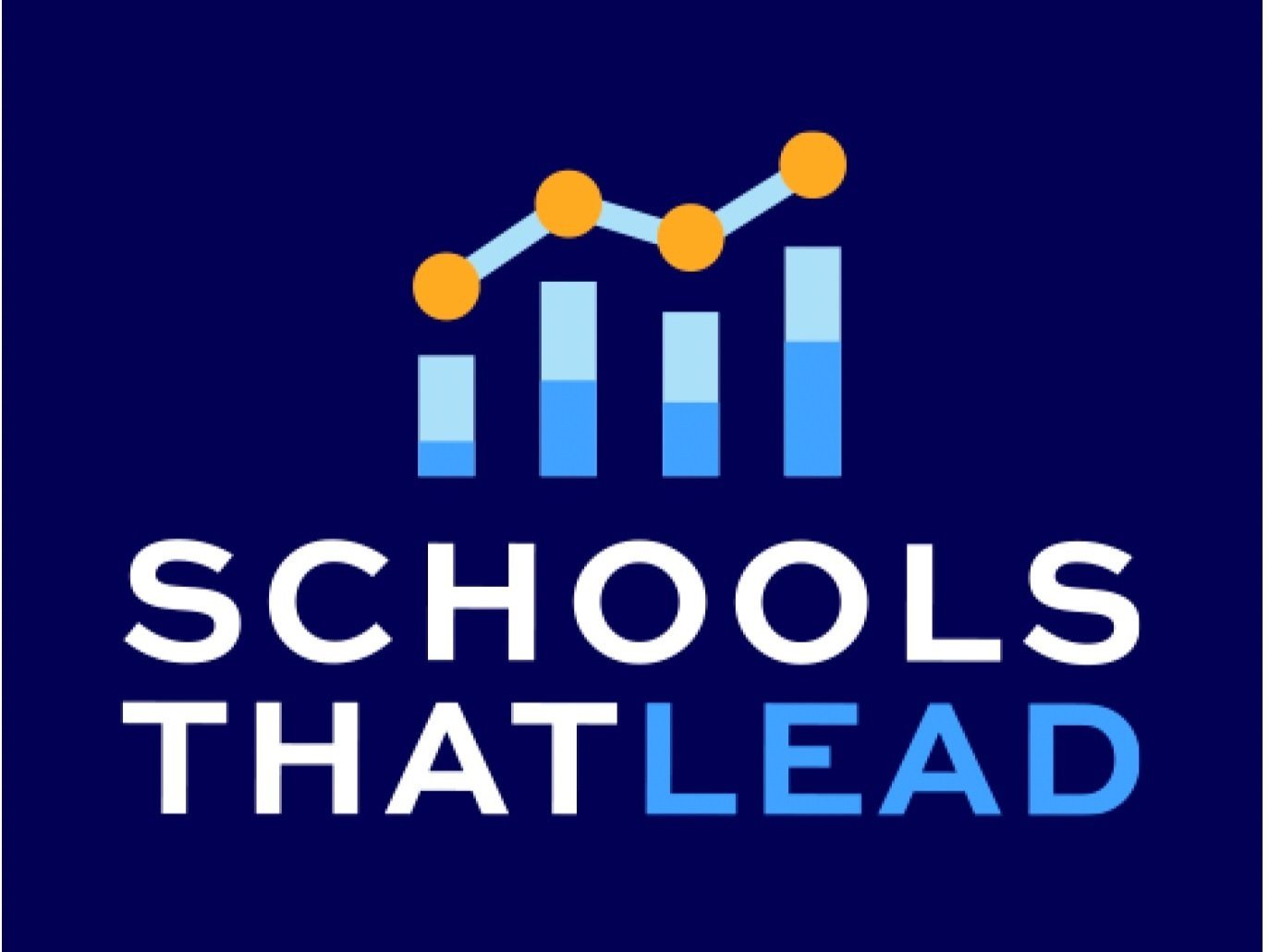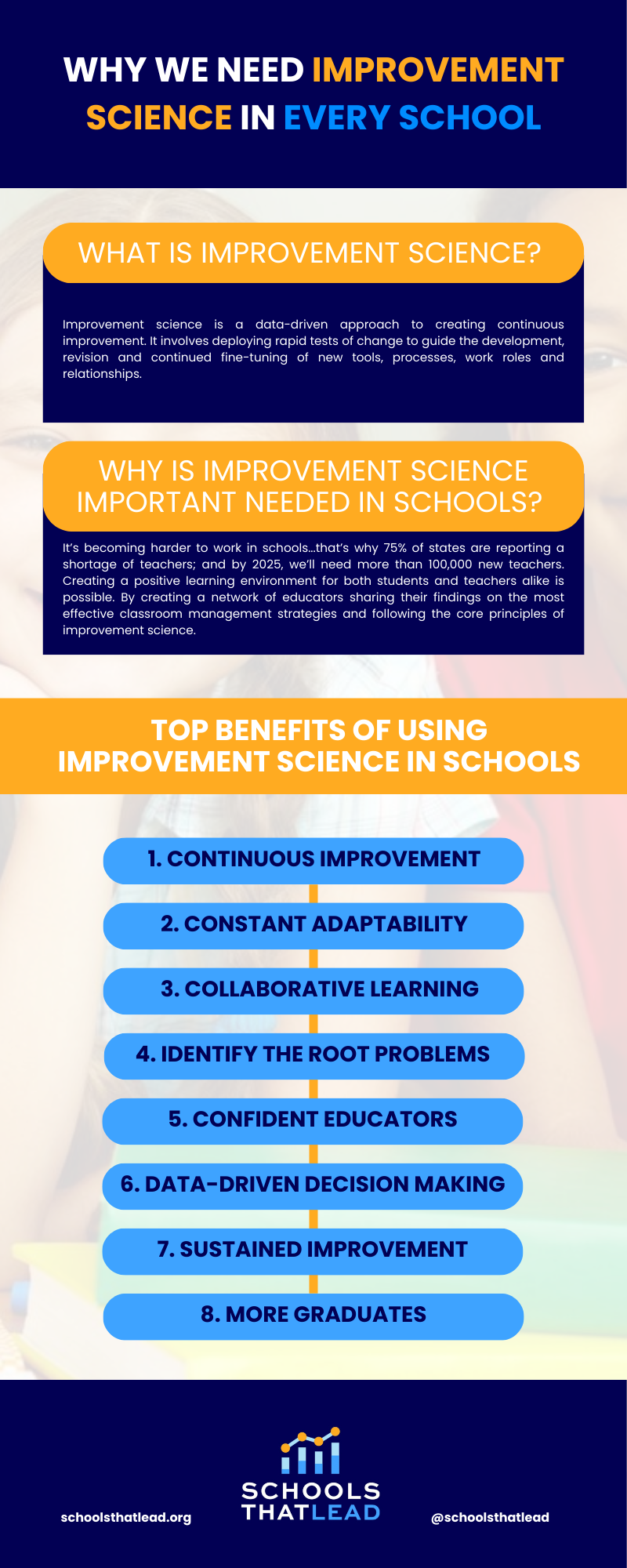Why Improvement Science is Key for Student Success
Improvement science is a methodical approach to making positive changes in organizations, but it is equally effective when applied in an academic setting. When applied in schools, improvement science becomes a powerful tool for putting students back on-track for success in the classroom.
Students and teachers in our schools are desperately in need of solutions and a path to get American education back on track. In the 1980s, America was the leader in quantity and quality of high school diplomas. In 2015, the US was ranked 36th in the world.
Improvement science in schools involves educational leadership identifying gaps that affect the performance of all students in a school or district. It also requires disciplined inquiry by administrators to categorize successes and failures, which can then be used as a blueprint for a school improvement plan.
What is Improvement Science?
Improvement science is a learning approach to continuous enhancement across organizations, particularly in educational settings. According to McRel International, it enables schools to make informed, impactful enhancements to student outcomes while actively engaging educators.
Rooted in data-driven decision-making and iterative cycles of testing and adaptation, it empowers educators to identify and address complex challenges faced in classroom management. Through collaborative learning communities of educators, improvement science ensures the targeted application of evidence-based interventions and promotes teacher adaptability. Improvement science also emphasizes sustainable, positive change.
Why is Improvement Science Important in Schools?
Students falling off-track in their academic journey have a direct correlation with an educator’s satisfaction in their profession. This is especially worrisome, with over 75% of states facing a teacher shortage in 2023, according to the U.S. Bureau of Labor Statistics. The teacher shortage is bound to turn into an American education crisis, with the demand for teachers expected to outpace the supply by over 100,000 by 2025.
Creating a positive environment for students and teachers is not mutually exclusive. That’s why a shift to implementing improvement science is an immediate need.
Top 8 Benefits of Implementing Improvement in Schools
Here are some of the key benefits of school administrators implementing improvement science in schools:
1. Continuous Improvement
Improvement science, at its core, is about striving to make continuous improvements. In schools, which have a constantly changing student body that is highly influenced by their environment outside of school. That’s why it's essential that principals and teachers remain adaptable.
A scientific approach to student success provides schools with a plan to make continuous improvements. Improvement sciences uses a cycle called Plan-Do-Study-Act (PDSA), where educators test new classroom management strategies, identify what works, learn from it, and then tweak their strategies to boost student engagement for the long term.
2. Data-driven Decision Making
Improvement science places a strong emphasis on data collection and analysis. In the context of school improvement, this involves the analysis of a wide range of data sources, including the on-time graduation success rate and classroom attendance. By making decisions based on empirical evidence, schools can identify areas for improvement, set realistic goals, and measure progress accurately. Data-driven decision-making ensures that educator-student interventions are targeted and tailored to address the specific needs of a student.
3. Collaborative Learning Communities
All high-performing schools are the result of a collaborative effort. Improvement science emphasizes the development of collaborative learning communities within schools and districts. Through these communities, teachers, principals, administrators, and other educational leaders come together to share insights and lend their expertise. This collaborative approach not only enhances the collective intelligence of the school’s faculty but also creates a culture of shared responsibility for improvement. By working together, schools can leverage the diverse skills and perspectives of their staff, leading to more effective problem-solving and a holistic approach to continuous improvement.
Schools That Lead is a dedicated team of educational leaders that supports school superintendents, principals, teachers, and administrators through the principles of improvement science with the aim of enhancing student learning.
4. Focus on the Right Problems
Improvement science’s approach encourages schools to prioritize the most critical challenges affecting student outcomes, according to the University of Pittsburgh Research Guide on Improvement Science. Instead of adopting generic or one-size-fits-all solutions, educators using improvement science engage in a deliberate process involving problem identification and prioritization. That ensures that efforts are concentrated on addressing the root causes of specific issues in the classroom, leading to more impactful and sustainable changes.
5. Tested Interventions
The application of improvement science in schools involves testing interventions on a small scale before widespread implementation in a regional school district. By following the PDSA cycle, it allows schools to pilot new strategies, learn from the results, and optimize existing policies as necessary.
Testing interventions in the classroom on a small scale minimizes the potential negative impact of unproven classroom management strategies on a broader scale. As a result, it promotes evidence-based decision-making by ensuring that interventions have been proven effective in a classroom/school before scaling implementation.
6. Adaptability
Schools have a student body from diverse towns and neighborhoods, each with its own unique challenges. Improvement science recognizes the importance of context and allows for flexibility in implementing classroom management strategies. Schools can tailor improvement efforts to their specific needs, considering factors such as the socioeconomic background of students, cultural context, and community dynamics. This adaptability ensures that improvement initiatives resonate with the local context, increasing the likelihood of student success.
7. Sustainable Change
Improvement science goes beyond quick fixes by embedding improvement processes into the fabric of a school's culture. Instead of relying on sporadic or short-term initiatives, improvement science seeks to create lasting change. By establishing a culture of continuous improvement, schools develop the capacity to navigate challenges effectively over the long term. This cultural shift ensures that positive changes become ingrained in the daily practices of the faculty, contributing to consistently hitting goals for student attendance, graduation success rate, and academic performance.
8. Empowering Educators
Improvement science places educators at the forefront of the improvement process. Teachers and administrators become active participants in identifying problems, proposing solutions, and assessing the impact of interventions. This empowerment not only enhances the quality of teacher and school administrator decision-making but also boosts faculty morale and satisfaction in their profession. When educators feel engaged and empowered, they are more likely to invest in classroom improvement initiatives, which contributes to a positive and collaborative school culture. Educators are also encouraged to participate in learning cohorts as part of their professional development.
The Bottom Line
Improvement science emerges as a cornerstone for success in schools by providing a comprehensive and systematic framework for continuous enhancement. Its focus on data-informed decision-making, collaboration, targeted problem-solving, tested interventions, adaptability, sustainability, and educator empowerment positions it as a powerful tool for navigating the complex landscape of education. By embracing improvement science, schools can not only address current challenges effectively but also build a resilient foundation for future success.
Learn more about Schools That Lead’s impact on North Carolina schools.
Frequently Asked Questions:
1. Can Improvement Science be Applied in Any Educational Setting?
Improvement science is adaptable to various educational settings, from marginalized communities in developing countries to advanced educational systems. The Millions Learning Real-time Scaling Labs exemplify its global applicability. This approach, rooted in healthcare, uses iterative cycles for testing and adapting strategies based on data. It emphasizes customization to each educational environment's unique needs and challenges, making it a versatile tool for diverse educational contexts.
2. How Do Improvement Science Tools Facilitate Better Teaching?
Improvement science tools enhance teaching by enabling data-driven strategies and collaborative methodologies. The Plan-Do-Study-Act (PDSA) cycle allows educators to test, assess, and refine teaching methods, fostering continuous improvement. Collaborative learning communities within schools further support this, enhancing collective intelligence and support among teachers. These tools ensure targeted interventions, leading to more effective teaching and improved student outcomes.
3. How Does Improvement Science Address Diverse Learning Needs?
Improvement science addresses diverse learning needs through tailored, evidence-based interventions. It employs data-driven decision-making to identify specific student support areas, enabling educators to develop targeted strategies. The approach's adaptability allows schools to tailor efforts to their demographic and cultural contexts, ensuring relevance and effectiveness. Its iterative nature ensures evolving strategies in response to changing student needs, fostering a culture of continuous adaptation.
4. What Challenges Might Educators Face When Implementing Improvement Science?
Implementing improvement science poses challenges like resistance to change, the need for training in data analysis and iterative testing, and resource constraints. Time constraints and balancing new methodologies with existing duties can be difficult. Additionally, gaining and maintaining stakeholder buy-in, including from students, parents, and the community, is crucial for successful implementation. Overcoming these challenges is key to creating a responsive and effective educational environment.
5. How Can Improvement Science be Integrated into Existing Curricula?
Integrating improvement science into curricula involves embedding its principles into curriculum design, including data-driven decision-making and iterative testing. Educators can use data to adapt curriculum to student needs. Professional development in improvement science methodologies is crucial for teachers. Collaborative learning communities support this integration, allowing educators to share strategies and experiences. Including improvement science as a curriculum topic teaches students iterative learning skills. Aligning these initiatives with broader school improvement plans ensures a cohesive approach, enhancing the overall educational quality and effectiveness.

TAQWANDA HAILEY
Taqwanda is the Chief Analytics Officer for Schools That Lead. With a Bachelor of Science in physics from North Carolina Central University, she has taught both secondary school and community college courses.




